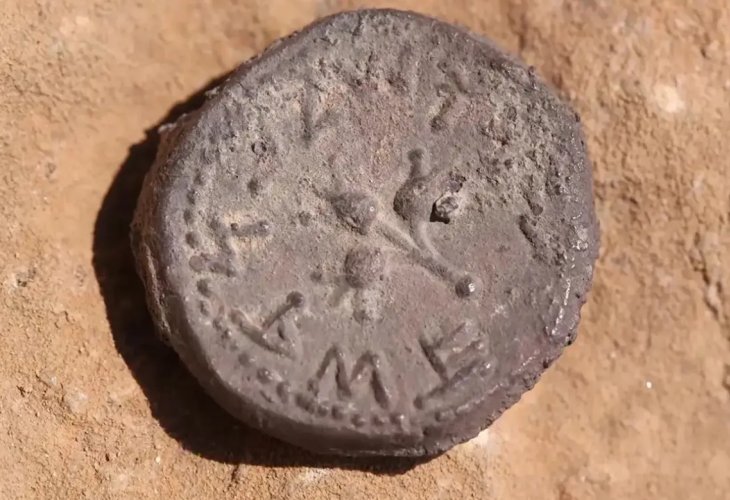Ancient Silver Coin Unearthed in the Judean Desert
A rare silver coin from the Jewish revolt against the Romans was found during a cave survey in the Judean Desert. The coin bears the inscription 'Jerusalem the Holy' in ancient Hebrew script.
 The silver coin as it was found (Photo: Amir Eljam, Israel Antiquities Authority)
The silver coin as it was found (Photo: Amir Eljam, Israel Antiquities Authority)A rare half-shekel silver coin, approximately 2,000 years old, from the time of the first Jewish revolt against the Romans, has been unearthed in the Judean Desert near En Gedi. The coin is inscribed with 'Jerusalem the Holy' in ancient Hebrew script.
According to the Israel Antiquities Authority, the coin is dated to 66 or 67 CE and was discovered during the sixth year of an archaeological cave survey in the Judean Desert managed by the authority in collaboration with the Ministry of Heritage and the Archaeology Staff Officer in the Civil Administration. The mission aims to secure archaeological treasures before looters can steal them.
Recently, during this comprehensive survey examining every cave and crevice, authority inspectors arrived at a cliff section in one of the streams near En Gedi. At the entrance of a cave, they noticed a silver coin partially exposed on the ground. One hypothesis suggests that the coin was dropped by rebels who descended into the desert during the revolt—perhaps on their way to nearby En Gedi. Such an incident could explain how the coin traveled from Jerusalem to the desert.
Yaniv David Levi, a researcher in the Coins Branch of the Israel Antiquities Authority, explains why the inscription on the coin 'Jerusalem the Holy' was written in a script lacking the full spelling: “It may be evidence of the inscription's formulation process, where in the later years of the revolt, the inscription 'Jerusalem the Holy' was written in full script.” Levi notes that “in the center of the coin are three pomegranates, a symbol also recognized from the Israeli lira coin, which served Israel until 1980.”
The other side of the coin features a chalice with the Hebrew letter Aleph ('א') above it, denoting the first year of the revolt, as well as the inscription 'Half-Shekel,' indicating the coin's value. The chalice was a typical symbol for the coins used by the Jewish population at the end of the Second Temple period. These coins were minted in denominations of 'Shekel' and 'Half-Shekel' during the first revolt against the Romans, which ended with the destruction of the Second Temple in Jerusalem.
In keeping with the commandment "You shall not make for yourselves an idol," from the Ten Commandments, Jews traditionally minted coins with plant symbols and motifs of religious holy objects. In contrast, the pagan population presented coins with everyday motifs, including emperors' faces and animals.
The Israel Antiquities Authority notes that it seems the Jewish rebels minted their own silver and bronze coins, featuring Jewish symbols and motifs, as an act of defiance and to create an internal economy for the revolt. It's no surprise that the rebels chose to use these coins with ancient Hebrew script, which had been prevalent centuries earlier, instead of the Greek script used during the Second Temple period.
“Coins from the first year of the revolt, like this one uncovered in the Judean Desert, are rare,” adds Yaniv David Levi. “During the Second Temple period, pilgrims traditionally paid a half-shekel tribute to the Temple. The accepted coin for this tribute for nearly 200 years was the 'Tyrian Shekel.' When the revolt began, the rebels issued alternative coins, marked with 'Shekel Israel,' 'Half-Shekel,' and 'Quarter-Shekel.'”
Amir Ganor, Director of the Antiquities Theft Prevention Unit at the Israel Antiquities Authority, emphasized that “discovering a half-shekel silver coin from the first year in organized archaeological activity is a rare event in our country overall, and especially in the Judean Desert. Every find from the survey provides additional information on the history of the land and its people. The find illustrates the importance of systematically and professionally surveying the entire area of the Judean Desert. Without this survey operation, the coin could have fallen into the hands of antiquities thieves and been sold to the highest bidder on the antiquities market. Over six years of the operation, we have documented over 800 caves and found thousands of valuable and important artifacts.”

